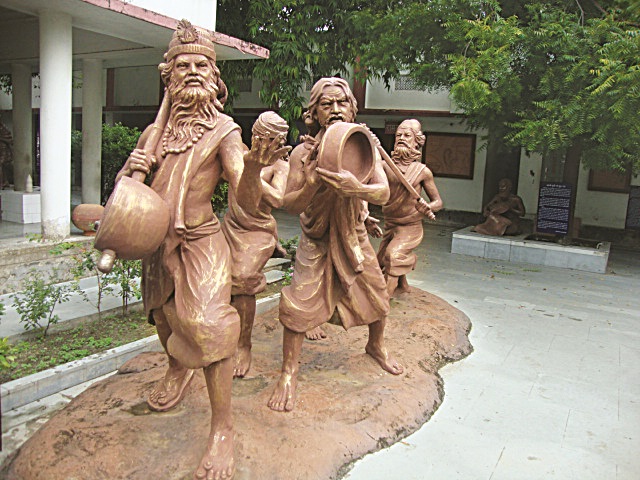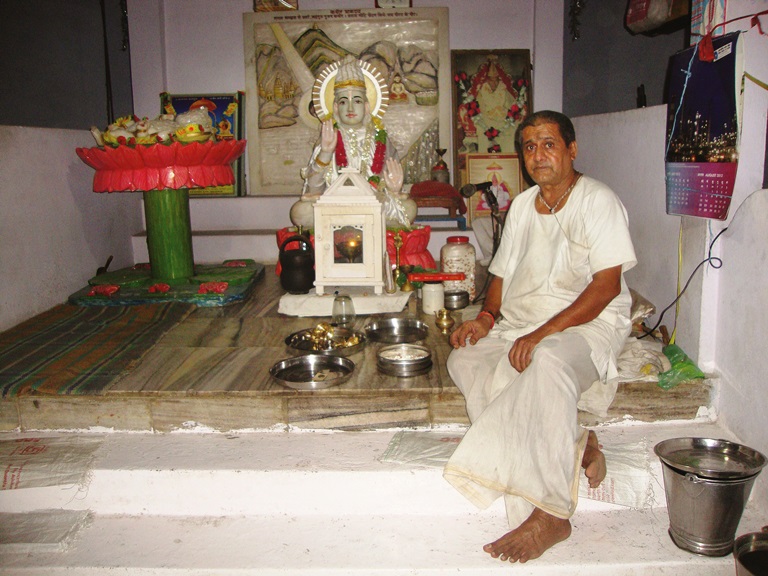Kabir walked our land about 600 years ago. His thoughts, however, have had a long-lasting impact on our society. In those days, our society was feudal. Caste-based discriminations, superstitions and Brahmanical rituals informed the Hindu tradition, and made life hell for the common man. The basic rights of the suffering masses – whether Hindus or Muslims – were usurped by the rulers and feudal lords. Hindus and Muslims were baying for each other’s blood.
The feudal system was in cahoots with the Brahmanical religious order. In such times, if someone appeared and showed the path to realizing one’s true self, it was natural for the people to get overwhelmed with joy and rush towards him. The result was the beginnings of a Kabirite movement that promised to free the people from the shackles of the prevalent religious rituals and sacraments. Under the banner of ‘Kabirpanth’, a band of his disciplines began spreading his views in society.

In Kabir’s times, only two religions were in vogue in India. Before him, the revolutionary Buddha and Mahavira had come and gone and the impact of Buddhism and Jainism had abated, mainly due to the atrocities by the Hindutvadi rulers and powers on the adherents of these religions. Hindu religion was again ailing and was back as a terrorising and dominating force. Kabir, who is described as illiterate, appeared in such a difficult phase as a beacon of light and propagated a humanistic path for both the Hindus and the Muslims steeped in outward customs and traditions. The Kabirpanthis try to carry this message forward and they got the support of right-thinking Hindus and Muslims who believed in humanism.
It was not possible to follow Kabir while sticking to the outward customs and traditions of Hinduism and Islam. And once you discard the outward customs and traditions, what is left in these religions? And so, the path of pure Kabirpanth was paved with many dilemmas and impossible-to-follow conditions. One could become a true Kabirpanthi by discarding one’s religion. But there is no evidence to suggest that even the greatest of Kabirpanthis ever declared that he had given up his birth religion. I believe that the trend of continuing to be an adherent of Islam or Hindu religion while embracing Kabirpanth is what rendered the cult spineless.
There are numerous examples of the selfish elements of the so-called high Varnas wearing the cloak of Kabirpanth just to acquire the leadership of the community or occupy high offices. Most of the prosperous and influential Kabir mutts are headed by feisty mahants who hail from upper castes. At the same time, the non-elite among the upper castes never adopted Kabirpanth. The cult’s basic and key following was among the lower classes of Hindus and Muslims. The elite class of both the religions had entrapped the oppressed castes in superficial and outward customs and traditions, depriving them of their basic rights as human beings.

Even in today’s age of science and logic, Kabir and his followers have no decisive influence on our society. The maxim of ‘too many cooks spoil the broth’ applies perfectly to Kabirpanth. The bloody, lustful and selfish battle for acquiring control over Kabirpanthi mutts owning huge movable and immovable assets bears an uncanny similarity with the battles routinely fought for grabbing control over Hindu mutts and temples. This is a cruel joke, a mockery of Kabir’s teaching of “Sai itna dijiye, ja mein kutumbh samaye” (Oh Lord, give me only as much as would suffice to feed my family). The inmates of these mutts seem to have adopted the mindset of Kamaal (Kabir’s son who was opposed to his father’s thoughts and beliefs). To quote Kabir’s famous couplet, ‘Maya mari na man mara, mar-mar gaye sharir; Asha-trishna na mari, kah gaye das Kabir’ ( The lust for material gains, the desire to acquire more and more does not die, even though the body may die; hope and greed never die, says Kabir)
Some Kabirpanthis are so fanatic that they sprinkle water on a piece of wood to sanctify it before putting it in the hearth and some take their commitment to the cult so lightly that the ‘kanthimala’ they wear around their necks is their only link with Kabirpanth. Otherwise, they visit temples every morning and evening, worship idols and do not eat even in pure vegetarian restaurants. They do not touch soya chunks as they taste and look like meat. There are also Kabirpanthis who do not eat or drink anything
in the house of a non-Kabirpanthi.
There is another pertinent question. Whether the guru should be a guru by birth or should his knowledge and learning make him a guru? In the Brahmanical/feudal order, son follows the father to the throne no matter whether he is has the ability to occupy that position or not. Kabir would have never approved of the position of guru becoming hereditary. It is horrible that the hereditary system has struck roots in Kabirpanth.
Religion-related miracles have played a major role in making the Indian mindset impervious to logic. But some communal books of ‘Kabirpanth’ describe in detail the miracles performed by Kabir and the Sadhus and Mahants of Kabirpanth. Some Kabirpanthi leaders and mahants have fallen as low as to sell the ‘Ganda-tabij’ and magical herbs and they have even got into the business of exorcising ghosts. It is important that the committed Kabirpanthis and those fighting against Puranic mindset should refrain from saying anything that supports the myths of Hinduism. But it is common for Kabirpanthi saints and mahatmas to quote from the Ramcharitmanas and Gita while elucidating Kabir’s teachings.
Our society still needs Kabir and that is why questions are being raised about the role of Kabirpanthis. One doesn’t know whether and to what extent Kabir impacted his contemporary society. No conclusive information is available on that count. But the pertinent question is how Kabirpanthis are different from Hindus and the followers of other religions and cults? If Hindu rituals are replaced by new rituals, old mantras are replaced by new mantras and ‘puja-path’ by ‘chauka-aarti’, where is the change? This may have made the cult popular but it has definitely not led to a wider acceptance of Kabir’s teachings. Kabirpanthis should have, in fact, carried Kabir’s teachings forward. The common man should have been introduced to Kabir’s modern outlook and his eternally-valid beliefs and thoughts. That awareness, which was central to the struggle of revolutionaries and forward-thinking people like Kabir against the self-appointed keepers of public confidence, should have been spread among the masses. Today, no one wants to struggle. Not Marxists, not Kabirpanthis, not Buddhists, not Jains. Though Leftists and Ambedkarites inspire some hope their organisational framework is weak. The Indian Leftists seem to have lost their way. Here also, like in the case of Kabitpanth, Savarnas occupy all positions of power and influence. In Kabir’s words “Antar tere kapat katarni….” (In your heart there is the scissor of deceit…). Though there might be a couple of non-savarnas in the top echleons of the Leftist outfits they are the exception, not the rule.
Till the Kabirpanth makes an effective and meaningful intervention in the social milieu, it would not be able to justify its existence and objectives. Currently, Kabir is being publicly ridiculed by his so-called followers. A rebel by nature, Kabir quit Kashi – the Hindu pilgrimage centre and the place where he lived and worked – and chose Maghar to die. It is said that whosoever dies in Maghar goes straight to hell. His message was clear. But the Hindus and Muslims conducted his funeral with their own different rites. There is a Hindu-mazar and a Muslim-mazar of Kabir in Maghar. In Bihar, there is a ‘Kushwaha Kabirmutt”. Does that surprise you? Are you shocked?
Published in the January 2013 issue of the Forward Press magazine
Forward Press also publishes books on Bahujan issues. Forward Press Books sheds light on the widespread problems as well as the finer aspects of the Bahujan (Dalit, OBC, Adivasi, Nomadic, Pasmanda) community’s literature, culture, society and culture. Contact us for a list of FP Books’ titles and to order. Mobile: +919968527911, Email: info@forwardmagazine.in)





